There are many versions of ragù alla bolognese that do not have much to do with the original from the city of Bologna. They may be tasty pasta sauces, but in my opinion they should be given another name such that when a pasta sauce is called ragù alla bolognese, you know what you can expect (a slow-cooked meat sauce with tomato, not a tomato sauce with meat, and with the classic ingredients that do not include fish sauce, garlic, mushrooms, or parsley, to name but a few). I’ve already posted a classic recipe for ragù alla bolognese, so that is not what this post is about. In that post I referred to it as ‘slow food’. And it is slow, as the classic preparation requires at least 3 hours.
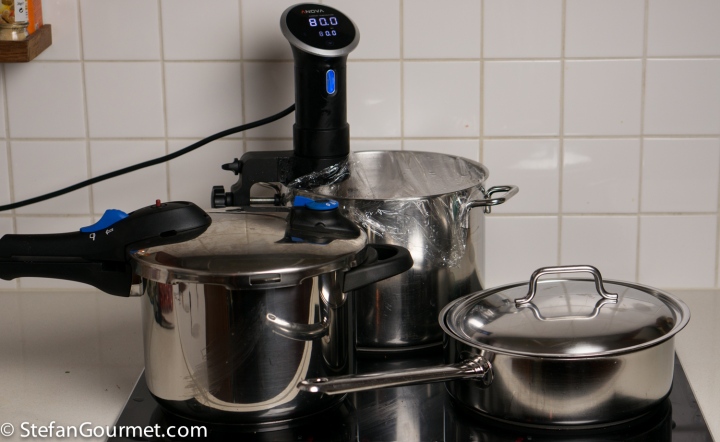
I’ve seen two cooking techniques for bolognese that I wanted to try for myself in a side-by-side experiment: in the pressure cooker, cutting down the time to an hour and 20 minutes, and sous-vide, taking the time to about 7 hours. In this post I will describe the experiment that I performed to find out whether the pressure cooker allows you to make a ragù that is as good as the traditional version in less than half the time, and whether it is worth to take the extra time and trouble to prepare it sous-vide.
Ingredients
500 grams (1.1 lbs) ground beef, or a mixture of veal, beef, pork and/or lamb
65 grams (2.2 oz) prosciutto, sliced and chopped
35 grams (1.3 oz) pancetta, diced
500 ml (2 cups) sieved tomatoes (passata, tomato puree), or 65 grams double-concentrated tomato paste for the sous-vide version
125 ml (1/2 cup) dry white wine
125 ml (1/2 cup) whole milk
75 grams (1/2 cup) minced onion
75 grams (1/2 cup) minced carrot
75 grams (1/2 cup) minced celery
2 Tbsp olive oil
dash of freshly grated nutmeg
salt and freshly ground black pepper
Common start of the preparation
To eliminate as many sources of differences between the three batches as possible, I started by preparing a triple batch all in the same pan, which I later divided into three equal parts before continuing with the three separate batches for each cooking technique. This way, the meat in all three batches is browned exactly to the same degree, to name just one possible source of differences that would interfere with a fair comparison between cooking techniques.
First I cooked the diced pancetta in olive oil…
…until it started to crisp. (I should have diced the pancetta a bit more finely.)
Then I added the minced carrot, celery, onion, and prosciutto…
…and stirred over medium high heat until it started to get golden, about 5 minutes.
Then I added the ground beef, stirring it with wooden spatulas to break it up…
…until the raw meat color was gone. Some recipes tell you to brown the meat very well, but for this experiment I thought that would eliminate at least in part the advantages of cooking the meat sous-vide.
Then I added the white wine…
…and stirred over medium heat until most of the wine had evaporated.
As a final touch, I added a dash of freshly grated nutmeg. The preparation up to this point took 20 minutes. Then I separated the contents of the pan into three batches of equal size, making sure that both the solid and the liquid part were evenly distributed between the three batches.
Batch #1: Pressure cooker
For the pressure-cooked batch, I put the meat in the pressure cooker and added the sieved tomatoes…
…followed by the milk…
…and then I stirred to incorporate.
Then I turned on the heat, and counted 30 minutes from the moment full pressure was reached.
After those 30 minutes, I released the pressure quickly by running cold water on the lid. (I could have waited for the pressure to drop naturally, but since I was trying to make this as quickly as possible, this made more sense.)
This is what the ragù looked like. As the pressure cooker does not allow for evaporation to take place, the ragù was still too watery and needed to be reduced.
So I reduced the ragù over medium heat until it had the proper consistency, about 30 minutes. I tasted and concluded it was not needed to adjust the seasoning with salt and freshly ground black pepper (remember that the prosciutto already contains salt and the pancetta both salt and black pepper.)
So in total 1 hour and 20 minutes for the pressure cooked version.
Batch #2: Traditional
Just as with the pressure cooked version, I added the sieved tomatoes…
…and the milk.
Then I stirred to incorporate, brought the ragù to a simmer, covered it…
…and simmered it over low heat for 2 hours and 40 minutes, stirring every 20 minutes or so, until it had the proper consistency (the same as the pressure cooked batch). I tasted and concluded it was not needed to adjust the seasoning with salt and freshly ground black pepper (remember that the prosciutto already contains salt and the pancetta both salt and black pepper.) So in total 3 hours for the traditional version. (You could also simmer it with even lower heat for an hour or so longer, which will provide even better results.)
Batch #3: Sous-vide
The sous-vide version that I found online uses tomato paste instead of sieved tomatoes, which makes sense as sous-vide doesn’t allow for reducing the tomatoes and reducing the tomatoes with the sauce would make the sous-vide version more like the traditional or pressure cooked versions. And so I decided to use tomato paste for my sous-vide version as well. I mixed the tomato paste with the milk before adding it to the meat.
When using a ziplock bag and the water displacement method, you can put the warm meat in the bag straight away and cook it for 5 hours at 80C/176F.
For a chamber vacuum sealer, the mixture needs to be cold before you can vacuum seal it, and you also need to cook it sous-vide for an additional hour as first the contents of the bag have to be warmed up again before the actual cooking process starts. With the additional cooling step and additional cooking time, the sous-vide process took 6 and a half hours.
After cooking sous-vide, the contents of the bag still looked quite similar.
I dumped the contents of the bag into a frying pan…
…and reduced it over low heat…
…to get the same consistency as the traditional version, about 10 minutes. I tasted and concluded it was not needed to adjust the seasoning with salt and freshly ground black pepper (remember that the prosciutto already contains salt and the pancetta both salt and black pepper.) The total time for my sous-vide version was 7 hours, but using a ziplock bag and the water displacement method that could be cut down to 5 and a half hours.
The color is a bit different from the other versions due to the use of tomato paste instead of sieved tomatoes.
The verdict
I allowed all three batches to rest in the refrigerator overnight, to allow the flavors to develop.
The most important conclusion is that all three batches were delicious. It was certainly possible to taste the difference when compared side-by-side by a trained palate, but the differences were small.
The flavor of batch #1, pressure cooked, was a bit less complex than the other two batches and the meat was slightly less tender than the other two batches. Most notably the tomato was slightly more acidic and slightly less sweet. I believe the lower and slower cooking of the other batches does a better job of developing the tomato flavor.
The flavor of batch #3, sous-vide, was more meaty and slightly more complex than batch #2, traditional. The meat was slightly more tender in batch #3 as well, but batch #3 was also slightly drier because there was less tomato to ‘lubricate’ the meat. I think the longer cooking time helped to get more complexity and a rounder flavor in batch #3. I think batch #3 was more meaty mostly because the 65 grams of double-concentrated tomato paste used in batch #3 was probably a bit less than the equivalent of the 500 grams of sieved tomatoes used in the other two batches. For a better comparison, the tomato paste in the sous-vide version should be substituted with 500 grams of sieved tomatoes, reduced separately or together with the milk until very thick. That would add another step and a longer time to the already lengthy sous-vide preparation. I am not sure if it is worth the additional trouble as compared to the traditional version.
In conclusion, the pressure cooked version is an acceptable solution if you are pressed for time. I am not sure if the extra time and steps for the sous-vide version are worth it. It does have the advantage that the sous-vide preparation is mostly unattended, whereas the traditional version requires regular stirring.
Flashback
Rack of lamb with carrot puree, ginger, thyme, and cumin are a delicious combination.





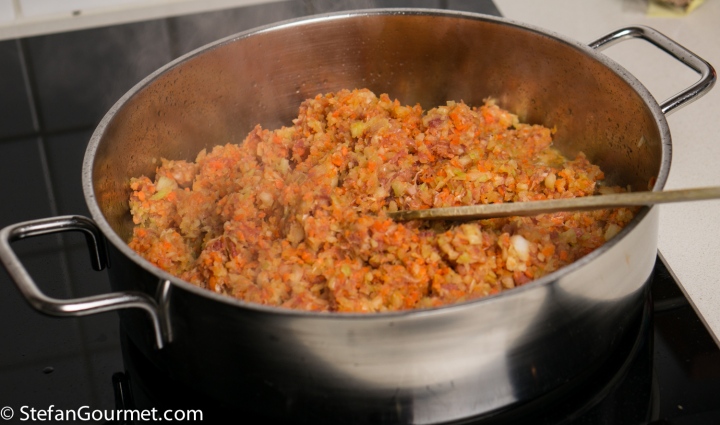





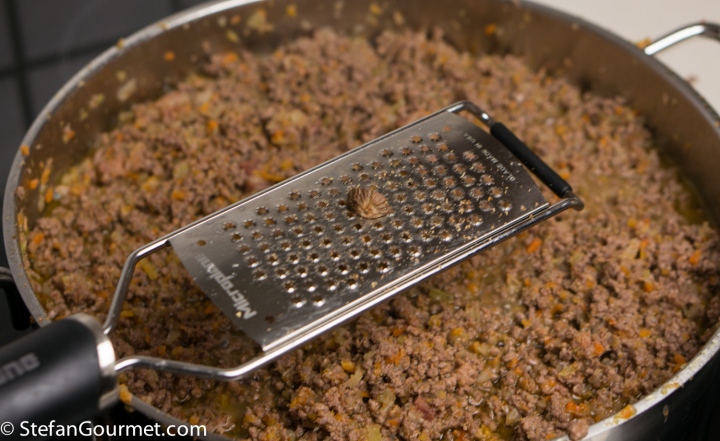


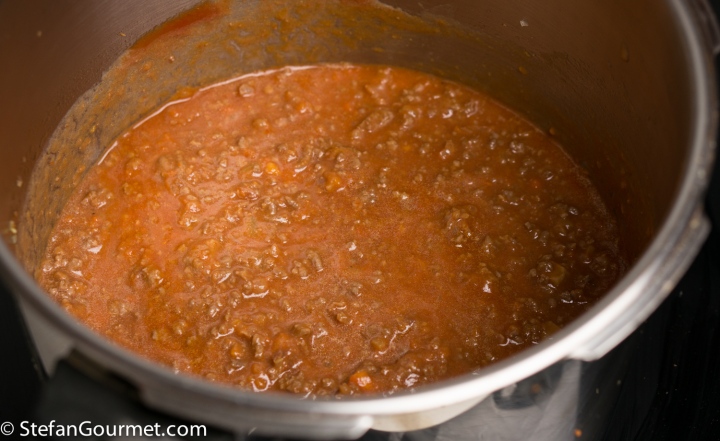







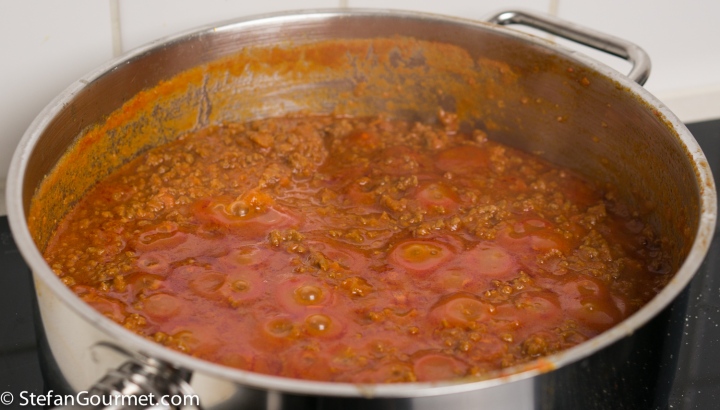
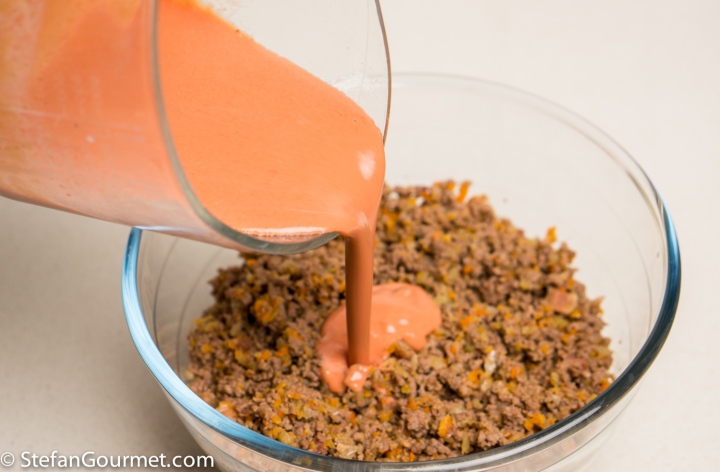

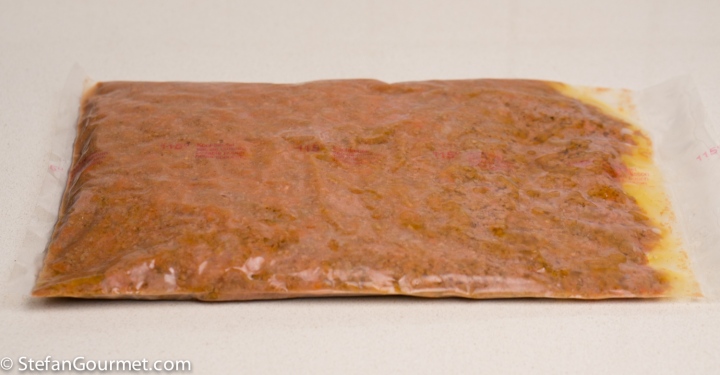






Great side by side comparisons!
LikeLiked by 1 person
Benchè sia una grande utilizzatrice della pentola pressione, il ragù non ce l’ho mai fatto. Chissà poi perchè!
LikeLiked by 1 person
Perché avevi già capito che per un buon ragù ci vuole del tempo?
LikeLiked by 1 person
Ma no, neanche. E’ una questione di abitudine. Anche per un buon brodo ci vuole tempo, ma nella pentola a pressione viene buonissimo, secondo me.
LikeLiked by 1 person
Hai ragione, il brodo va meglio nella pentola a pressione. Più sapore.
LikeLiked by 1 person
Have not made Bolognese for ages, but your lesson has put it on the schedule. Interesting and honest comparison twixt methodology: since I do not have a pressure cooker or use ‘sous-vide’ am ‘left’ with the traditional which sounds interesting to say the least and possibly the best. Have never included milk either: looked up your 2012 post and know more! With me it has to be 1/2 each beef and pork: no decent veal available . . . have to admit to having used spaghetti in my life, but love tagliatelle . . .
LikeLiked by 1 person
The Italians are known for their ‘campanilismo’, which I translate with a feeling of belonging to the nearest bell tower (rather than to the country as a whole). This is easy to understand if you know Italy didn’t exist as a single nation until 1860 (in other words, Australia is older in a way!). There is also campanilismo going on in the kitchen. I recently suggested to a blogger from Emilia to use gorgonzola in a recipe, and she stated the only cheese she’d use is the local parmigiano. I accused her of campanilismo and she admitted 😉 To a cook from Bologna, leaving out the milk and including garlic, or serving spaghetti, would not be considered for the same reason.
LikeLike
Well, this is new to me and oh so romantic when compared to the usually valid ‘but nonna taught me thus’ ! Thank you! In this case in will go the milk and out will go the garlic [yes well, I forgot to confess!] ‘Within the sound of the bell’ – how beautiful!!
LikeLiked by 1 person
Stefan! I’m here and it’s also 10:30pm and I’m still at work. Love this article. This is the kind of testing I love to do and I wish I could do more. When I cook ragu in the pressure cooker I cook the sieved tomatoes until very dark before pressure cooking and then I add the rest of the liquid, usually add some water to compensate but I make sure the tomatoes are fully cooked and develop their flavor as much as possible before pressure cooking. I dont’ bother with browning the meet. I have in the past but it has an effect on texture (makes the meet somewhat brittle)… at least in my testing. I should conduct a more serious test. A level of browning occurs at the bottom of the pressure cooker where the temperature might be high enough for the mailllard reaction to occur. Probably more of that happens when traditionally cooked. It would come down to making sure both stoves were set at the same temperature. Anyways, now you got me thinking about the sous vide option. This is a really interesting article. Thanks for putting this together!
LikeLiked by 1 person
Great comparison. Spaghetti “bolognese” is almost Australia’s national dish, but rarely is it good. Making is in the traditional method makes a huge difference IMHO, long slow cooking, and with milk added. I haven’t made it in ages, now on the to do list, thanks
LikeLiked by 1 person
Another ‘Australian national dish’ that I discovered, chicken parmy, is also a destroyed version of an Italian recipe 😉
LikeLiked by 1 person
Another great experiment Stefan. I love the idea of campanilismo. We are all guilty of a bit of that in one way or another. Your opening shot made me smile. I can see you as a sort of mad professor measuring, gauging and recording the various elements.
Best,
Conor
LikeLiked by 1 person
Interesting tests, Stefan, and how I wish I could have had a seat on the judging panel. Good idea, too, to let the sauces sit overnight before tasting. That certainly would have evened the playing field. Since I am no closer to purchasing either a pressure cooker or sous vide equipment, it’s good to know that traditional method results aren’t abysmal when compared to the others. That tiny patch of open counter space in my kitchen is safe for another day. 🙂
LikeLiked by 1 person
I love that you took the time to experiment with this, very interesting results! I love bolognese, but sometimes I don’t have the patience.
LikeLiked by 1 person
It freezes very well, so I make a huge pot a few times per year and freeze individual portions that can be defrosted and reheated in the time it takes to cook pasta.
LikeLike
Thanks Stefan for all the hard work! Love the opening shot too. Have you considered option 4, baker in the oven, as preferred by Seriouseats? This has been my way of preparing the sauce lately and I like the taste and texture beter than with the traditional method that I used before.
LikeLiked by 1 person
I did read about it on SeriousEats, but decided three batches was enough for this time around. I will try it when I run out of bolognese again (i.e. not very soon).
LikeLike
What an interesting experiment. Thanks for sharing it.
LikeLiked by 1 person
Thanks, fun experiment. As I said earlier I made my ragu in the Pressure Cooker, using though far less tomato: I use tomato paste (and not passata), just a couple of tablespoons for the amount of meat u use. I also cook the vegetables much longer (about 30 minutes, without browning), and I brow the meat separatly: for anyone interested in the science behind ragu making, do check the useful post (in Italian) by
by food scientist dario bressanini: it clarifies few important points
http://bressanini-lescienze.blogautore.espresso.repubblica.it/2011/06/13/le-ricette-scientifiche-il-ragu-alla-quasi-bolognese/
oven baked ragù serious eats: I tried it: good, but far too livery
LikeLiked by 1 person
Tomato paste is more strongly concentrated than passata. Cooking the vegetables for a long time is probably a good idea. Thanks for the link, I’ll check it out.
LikeLike